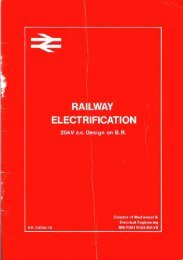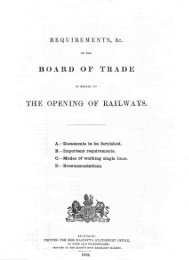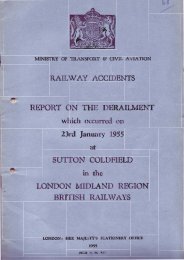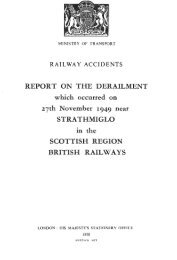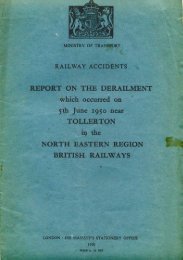R A I LT R AC K - The Railways Archive
R A I LT R AC K - The Railways Archive
R A I LT R AC K - The Railways Archive
You also want an ePaper? Increase the reach of your titles
YUMPU automatically turns print PDFs into web optimized ePapers that Google loves.
freight<br />
We can accommodate<br />
all forecast demand<br />
for at least the next<br />
five years<br />
86<br />
7.3 continued 7.4<br />
This forecast would represent a tripling of rail freight activity<br />
by 2009 from the base level in 1996,against a background of<br />
sustained decline since the war.<br />
Of the forecast:<br />
• international traffic is expected to more than triple and<br />
become 10% of all rail freight activity.<br />
• deep-sea intermodal is set to increase by 150% to 20%<br />
of the total market.<br />
• new business yet to be won to rail needs to increase<br />
fivefold and become 40% of the total.<br />
• about 10% of the increase would result from an<br />
improvement in the network’s capability with three-<br />
quarters of that due to improvements in the loading<br />
gauge.<br />
However, achieving this growth will require a reappraisal of<br />
the economics of operating and investing in rail freight.We<br />
do not expect customers to be able to commit to using<br />
current or new capacity well in advance of them securing<br />
additional traffic. It would meet the Government’s policy<br />
objectives if we could keep our track access charges low, to<br />
encourage more freight by rail.This was the essence of the<br />
track access contract that we developed with EWS in 1997.<br />
Since then, rail freight volumes have increased by 12% a year<br />
while our income has grown at 2% and,in line with the<br />
policy set by the Rail Regulator in 1996,our freight business<br />
has recovered its avoidable costs in aggregate.<br />
Committing large sums of money to capacity which is<br />
needed a long time in the future, based on high-growth<br />
forecasts,is imprudent,particularly when the economics are<br />
unattractive to the investor.<br />
We are discussing this major issue with the industry’s<br />
stakeholders,especially in the light of the proposals outlined<br />
in the Sustainable Distribution policy document (see Section<br />
1.6).For planning purposes, we have assumed that current<br />
track-access rates will continue.<br />
7.4 Routeing strategy<br />
Together with our customers, we have analysed their<br />
expected increase in demand by source and destination,<br />
route section,speed band and time of day, including the<br />
benefits of improvements in the network’s capability. We<br />
have then compared this demand with the current capacity<br />
and capability of individual routes and the anticipated growth<br />
in passenger traffic.<br />
We have confirmed that we can accommodate this<br />
forecast demand for at least the next five years across the<br />
network.Looking ahead ten years, we have committed to<br />
our customers that we can carry their forecast volumes of<br />
freight together with all declared passenger requirements<br />
within our existing capacity and planned investments on 38<br />
of our 45 routes.In total,these cover 60% of current and<br />
half of future traffic volume .We are now developing detailed<br />
timetabling solutions to confirm this conclusion.<br />
<strong>The</strong> remaining seven routes carry significant existing<br />
freight, and the majority of the growth.So, we have looked in<br />
more detail at:<br />
• growth on the key, longer-distance routes which handle<br />
the majority of traffic.<strong>The</strong>se are the West Coast Main<br />
Line (WCML) including its connecting branches,the East<br />
Coast Main Line (ECML),the Great Western Main Line<br />
(GWML),the North London Line, the Glasgow and<br />
South Western Line (G&SW),the Midland Main Line<br />
(MML),routes between London and the Channel Tunnel,<br />
connections between Southampton and the WCML and<br />
routes via Birmingham connecting Derby to Reading and<br />
Bristol.<br />
• a number of key multiroute flows which account for<br />
around 40% of current volume, 60% of the forecast<br />
increase and,therefore, more than half of the volume<br />
expected in 2009.<strong>The</strong>se flows include Scotland to East<br />
Midlands coal,traffic via the Channel Tunnel,the<br />
development of the Enterprise network,the Royal Mail<br />
business,deep-sea container traffic, domestic intermodal<br />
business,and steel traffic within and to and from South<br />
Wales and the North East.



